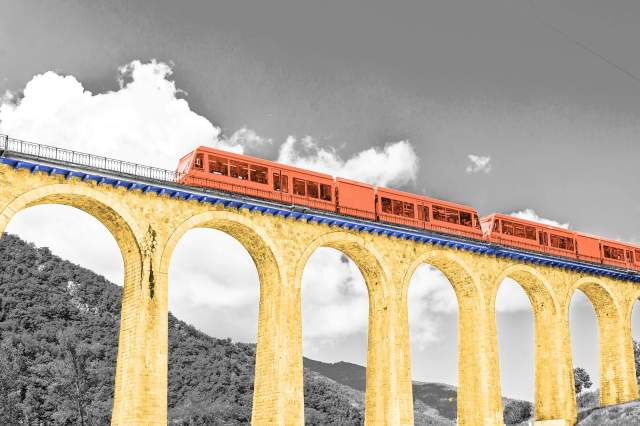
You Can Thank Trains for Time Zones
Before 1833, local time was all over the place; communities set their clocks to noon when the sun was highest in the sky, which led to at least 144 different local times in North America. This wasn’t a huge deal when people were traveling slowly by foot and horseback, but with trains, people could suddenly travel across wider distances more quickly — and train operators needed consistent schedules to coordinate. Even small miscommunications about time could lead to missed connections and accidents. Railroads established a four-time-zone system in 1833, and used it for decades before the U.S. government officially established time zones in 1918.

The Fastest Public Train Can Travel 286 MPH
Japan’s bullet trains are known for their lightning speed, but a handful of trains have eclipsed them — one of them being Shanghai’s maglev train, which uses magnetic levitation instead of wheels on conventional tracks. Its entire 19-mile run takes just seven and a half minutes, reaching top speeds of 286 miles per hour.
That’s just the tip of the iceberg for maglev trains. The fastest recorded train speed is nearly 375 miles per hour, clocked during a test run of a maglev train in Japan.

Railroads Used To Be Powered by Horses
The earliest railroad tracks were for horse-drawn trains, not locomotives. The tracks provided extra support and guidance, which meant that horses could carry greater loads. After the Liverpool and Manchester Railway opened with a steam-powered locomotive in 1830, jokes and cartoons about unemployed horses abounded, although horses were still used for shunting — moving trains from one line to another. Horses continued to haul streetcars into the 20th century.
More Interesting Reads

America’s First Locomotive Reportedly Lost a Race to a Horse
When the Baltimore & Ohio Railroad — you might know it as the B&O Railroad — began operations in May 1830, it used only horse-drawn carriages. Steam locomotives were in use in Britain already, but because the planned system in America had steep hills and sharp curves, some engineers doubted that the machines could handle the route. This concerned B&O directors, so they turned to an inventor named Peter Cooper to see if he could create an engine that was up to the task. He cobbled one together out of scraps, including an old brass engine, discarded wheels, and musket barrels. Later dubbed “Tom Thumb,” it performed beautifully along a 7-mile test run, then again on a 13-mile test, reaching a then-impressive 18 miles per hour.
According to an 1868 lecture at the Maryland Institute by B&O lawyer John H.B. Latrobe, who was present on the 13-mile test, Tom Thumb also took part in a bit of a race. The owners of a stagecoach company saw the engine running along the track and challenged Cooper to a race along double tracks. The engine got an early lead, but a part slipped off, causing it to come to a halt. It was a quick fix, but by the time Cooper got going again, the horse was too far ahead. Losing the race didn’t have any effect on Tom Thumb’s future, though — he’d already impressed the B&O directors, who were determined to make the locomotive the way of the future.

In Victorian Times, Trains Were Considered Hazardous to Your Health
As train travel was starting to get popular in the mid-19th century, rumors spread — among doctors and nondoctors alike — that trains were dangerous, and not because of crash risks. All sorts of woes were attributed to the speed and roughness of locomotive travel. Some believed it could trigger insanity and create “railway madmen.” Others claimed it could cause miscarriages or upset women’s delicate constitutions. One doctor said that a train trip made a patient’s “brain congestion” worse, even though he’d been feeling better after treatment with leeches.

New York’s MTA Turned Decommissioned Trains Into Artificial Reefs
When trains in New York City’s subway system get decommissioned, they can be sold, scrapped, or repurposed. Many of them can then be found on the ocean floor, providing homes for marine life as artificial reefs. Some car models work better than others; the Redbird cars, made of carbon steel, worked so well that states started competing for them. Redbird Reef in Delaware is home to around 700 such decommissioned cars, and they created a thriving ecosystem in an area that used to be barren. The stainless steel Brightliner cars, on the other hand, disintegrated almost immediately underwater — the material was vulnerable to corrosion, and their corrugated texture made it easy for currents to rip them apart.

The Longest Freight Train Was 4.57 Miles Long
It’s no fun getting caught at a railroad crossing and waiting for a long freight train to pass. But next time it happens, you can thank your lucky stars it’s not 4.57 miles long, like one train that ran in Western Australia in 2001. It was both the longest and heaviest train recorded. Pulled by eight locomotives, the 682 ore cars made a 171-mile journey transporting iron ore from a couple of mines run by mining company BHP to Port Hedlund.

Americans Used To Love Crashing Trains on Purpose
Before there was demolition derby, there were staged, head-on train collisions. From the 1890s through the 1930s, train crashes were a popular attraction at fairs and festivals, drawing tens of thousands of spectators. One of the biggest wrecks was an 1896 publicity stunt in Waco, Texas, for a struggling railroad line known as the Katy Railroad. The company offered rides to the crash site for $2 from anywhere in Texas, and built a temporary town around the viewing area, complete with a restaurant and jail. The crash itself created a massive explosion, which sadly killed two people in the crowd.
This is just one of the most famous out of hundreds of on-purpose train collisions. The most prolific train-wrecker was Joe Connolly, otherwise known as “head-on Joe.” Between 1896 and 1932, Connolly staged 70 wrecks and destroyed 146 locomotives — at least. He became an engineer of chaos, coming up with extra stunts such as strapping dynamite to the trains. The practice, which came to be viewed as wasteful, fell out of favor during the Great Depression.

It Takes Almost a Week To Ride the Full Trans-Siberian Railroad
The longest single-train ride in the world is the Trans-Siberian Railroad. The main track starts in Moscow and travels 5,772 miles through diverse Russian landscapes before arriving in Vladivostok, a large port city on the sea of Japan. The full journey takes more than six days.
Other routes on the network are the Trans-Mongolian Railroad, which heads through Mongolia to Beijing, China, and the Trans-Manchurian Railroad, which dips down into northeastern China before meeting the main line back in Vladivostok.












